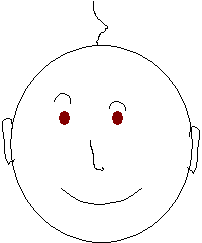
A simple stick figure of a face is not very sophisticated. Yet it symbolically demonstrates the major features of a human face: two eyes and ears, a nose, a mouth, lips, hair, eyebrows, and chin. When you are describing a friend to someone you give details about those features. "He has brown eyes, curly yellow hair, a big nose, and small ears", may not give a very complete picture of the person, but you might be able to recognize the person at a crowded party. It is the same with describing the atmosphere. With a general description of current atmospheric features you might be able to recognize certain weather patterns.
Children draw simple faces based on observations. They observe that the nose lies above the mouth and between the eyes. Eyebrows appear above the eyes and ears are on the side. To make a simple, conceptual model of the global wind patterns requires observations. You can use your own observations, historic records, and data from satellites to identify the major features of a stick model that represents the atmospheric circulation.
Simple mathematical models allow scientists to explore relationshipts between different features of the atmosphere. For example, how wind speed should vary with horizontal temperature gradient.
While all faces have the same basic features, few people look identical. It is the same with the atmosphere. You can identify many of the basic features of the atmosphere on most days, but you will not find two days with identical patterns.